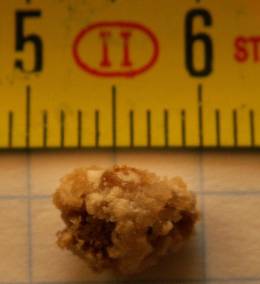Related article: Flank pain

Table of Contents
Kidney stones
Kidney stones, also called renal calculi, are crystal aggregations of dissolved minerals in urine. Kidney stones typically form inside the kidneys or bladder and can primarily consist of a variety of substances including calcium oxalate, uric acid, and struvite (magnesium, ammonium and phosphate). According to the Marshall PathogenesisA description for how chronic inflammatory diseases originate and develop., there are two factors that seem to play a role in kidney stone formation: elevated levels of 1,25-DPrimary biologically active vitamin D hormone. Activates the vitamin D nuclear receptor. Produced by hydroxylation of 25-D. Also known as 1,25-dihydroxycholecalciferol, 1,25-hydroxyvitamin D and calcitirol. and the presence of bacteria.
Patients on the Marshall Protocol (MP) are somewhat less likely to get kidney stones, especially in later stages of the treatment, due to the restoration of proper vitamin D metabolism. Those patients who do develop kidney stones since starting the MP, should know they are a result of months or years of development and not due to the effects of the MP. The MP should prevent recurrence.
Vitamin D
Epidemiological studies
According to a 2011 systematic review performed by the Cochrane Collaboration, “Vitamin D3Form of vitamin D made in the skin when exposed to light. Also available in fish and meat. This secosteroid is sometimes converted into 25-D. Also known as cholecalciferol and activated 7-dehydrocholesterol. combined with calcium significantly increased nephrolithiasis [kidney stones].”1)
A 1980 epidemiological study of lifeguards in Israel (who presumably were exposed to a great deal of sunshine) found that 11 of 45 (24%) had proven kidney stones, a rate twenty times the incidence in the general population.2)
Role of elevated 1,25-D
Kidney stones are a common co-morbidity in patients who suffer from diseases noted for hypercalcemia including Crohn's disease and sarcoidosis. However, many normocalcemic patients with Th1 diseasesThe chronic inflammatory diseases caused by bacterial pathogens. have suffered from kidney stones and calcium deposition into the soft tissue as a result of excess levels of 1,25-D. At levels above about 42 pg/ml, the 1,25-D (generated by Th1 inflammationThe complex biological response of vascular tissues to harmful stimuli such as pathogens or damaged cells. It is a protective attempt by the organism to remove the injurious stimuli as well as initiate the healing process for the tissue.) begins to stimulate bone osteoclasts, causing bone to be resorbed, or dissolved, back into the bloodstream, which can lead to kidney stones.
Evidence of infectious cause
It is commonly accepted that stones composed of struvite are “derived from bacteria.”3)
According to researchers, most struvite (also referred to as “triple phosphate stones”) were shown to be caused by Proteus or Providencia sub-species. In one study, Proteus mirabilis accounted for more than half of all urease-positive infections.4) Williams et al5) reported on 31 out of 39 patients with Proteus subspecies as the predominant urease-producing organisms. Pseudomonas, Klebsiella, Providencia, Serratia subspecies and Staphylococci accounted for the remaining cases.
Calcium oxalate stones are the most common form of kidney stones and there is emerging evidence they are caused by bacteria, specifically nanobacteria. Certain small intracellular bacteria have been shown to be capable of forming calcium phosphate shells that serve as crystallization centers for kidney stones.6) Kajander et al note that, even in urine supersaturated by calcium oxalate and uric acid, kidney stone formation does not proceed unless there is a “nidi” (a central point or focus of bacterial growth in a living organism).7)
Incidence and prevalence
Kidney stones occur in up to 15% of the population. Between 0.1 and 0.4% of people form a kidney stone every year. The recurrence rate is high, reaching 52% within 10 years and 75% within 20 years.8)
Patient interviews
<html> <div class=“patientinterviews”>
<html>
<div class=“patientinterviewboxl”>
<div class=“patientinterviewimage”></html> <html></div>
<div class=“patientinterviewtext”>
<div class=“patientinterviewname”></html>Guss Wilkinson<html></div></html>
<html></div>
<div class=“patientinterviewtext”>
<div class=“patientinterviewname”></html>Guss Wilkinson<html></div></html>
sarcoidosis, psoriasis, insomnia, kidney stones
Read the interview
<html></div></div>
<br clear=“left” />
</div> </html>
Interviews of patients with other diseases are also available.
Patients experiences
I have been a rapid stone developer for quite a few years. They're not calcium oxalate stones so diet isn't really helpful in lessening. I have staghorn stones.
My stones are invariably do not become painful until they enter the ureter, as they start to pass. That's when it goes off the charts. I do have flank pain regularly which I do not attribute to stones but to inflammation/disease of the kidneys. The way I can tell between stones and inflammation is the stones escalate greatly to a very high pain threshold – top of the charts – and then after passed the pain is relieved quite quickly.
But flank pain during treatment with antibiotics varies from quite painful (not off the charts like trying to pass a large stone) and back down the scale to moderate or dull coinciding with breaks I have taken on the MP.
Usually it is my right kidney that hurts the most (that has been the one that I have had infections twice a year since 13yrs old), but the left kidney with the 4+ cm cyst hurts much less than the right.
At any rate, the ultrasound will give you an idea if there is any calculi present, and you may chose to ignore for now, or opt to have them pulverized. I haven't had any pulverized and only had one hospitalization with an exceptionally large staghorn that didn't want to pass quick enough to my likings. The rest I have passed at home, catching for analysis.
I have had many stones sit in the kidney for long times though, and never give me any trouble. With the fluctuation of pain levels, I would tend to think inflammation due to another organ affected by Th1 diseaseAny of the chronic inflammatory diseases caused by bacterial pathogens..
~Hrts
[PMID: 21735411] [DOI: 10.1002/14651858.CD007470.pub2]
[PMID: 7424691] [DOI: 10.1007/978-1-4615-9167-2_51]
[PMID: 10650513] [DOI: 10.1097/00042307-200001000-00009]
[PMID: 6472365] [DOI: 10.1056/NEJM198409203111203]
[PMID: 12669155] [DOI: 10.1007/s00240-003-0304-7]
[PMID: 10756693] [DOI: 10.1024/0040-5930.57.3.138]


